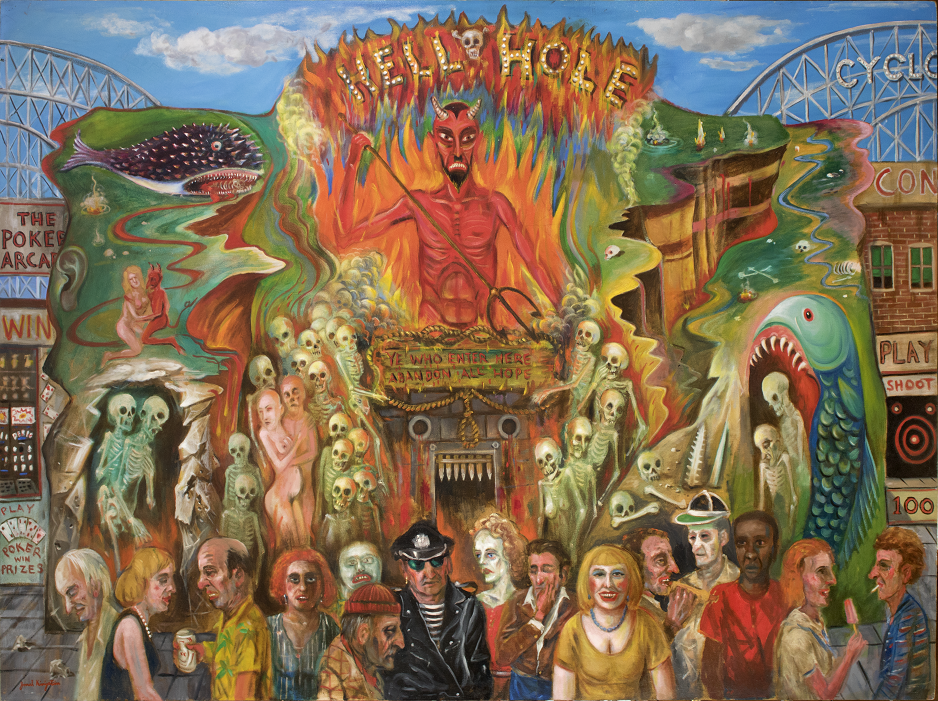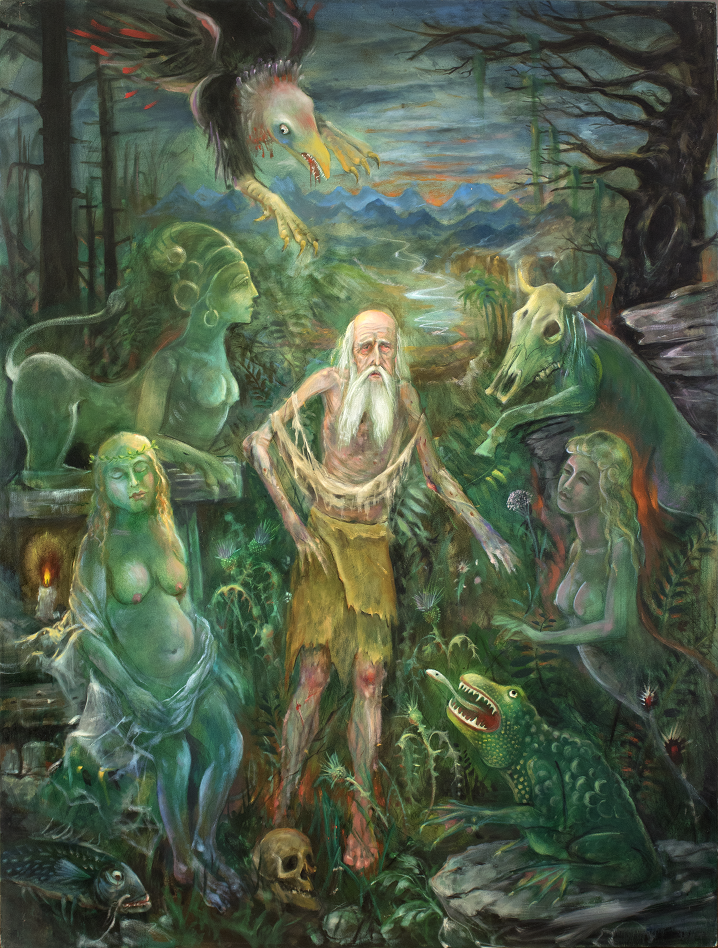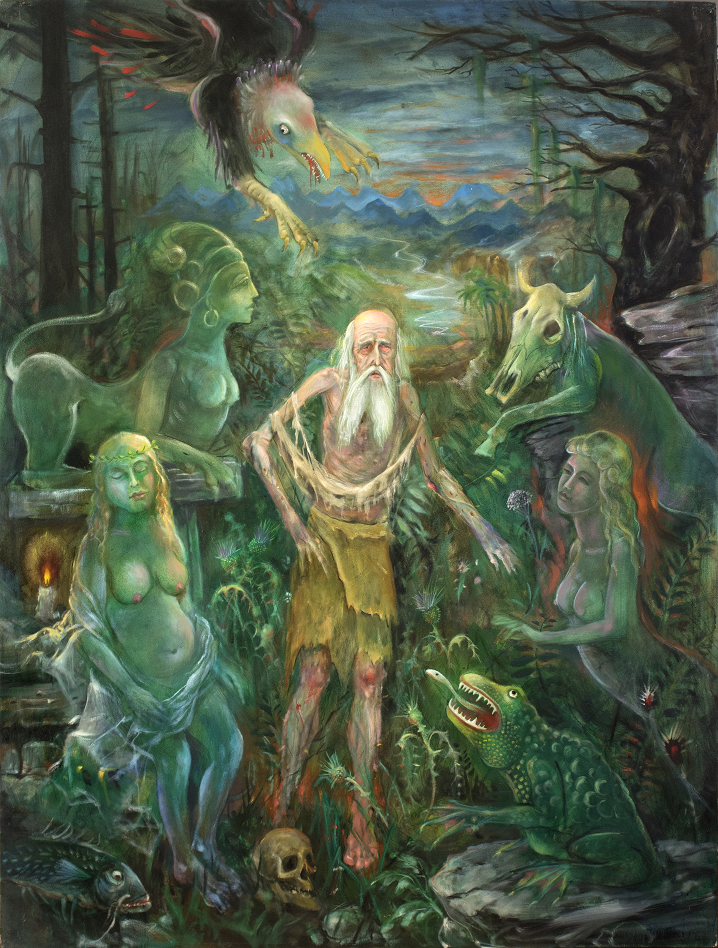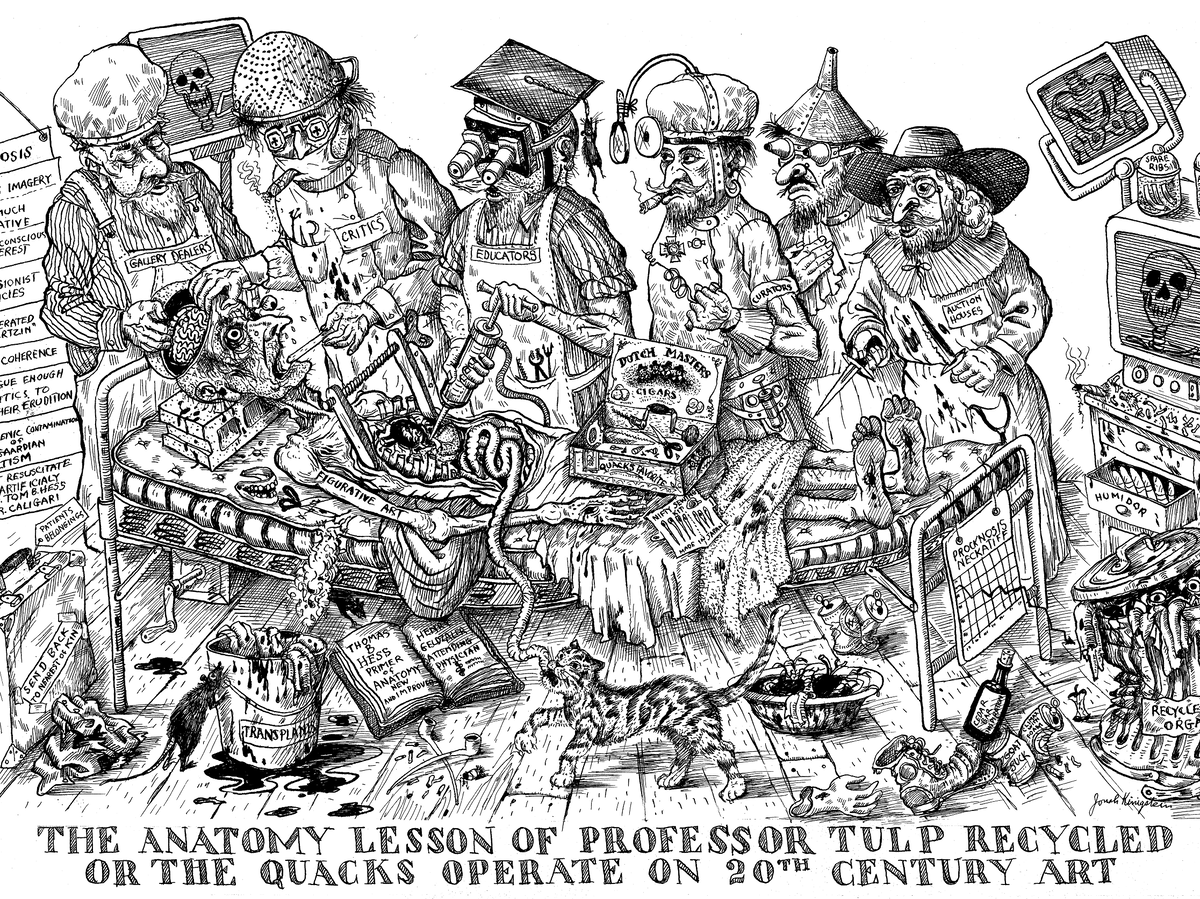
Jonah Kinigstein, 99, has been making art since he was a teenager. Some of his work satirizes modern artists such as Andy Warhol and Jackson Pollock, visible in the painting behind him.
Matthew Schuerman/NPR
hide caption
toggle caption
Matthew Schuerman/NPR

Jonah Kinigstein, 99, has been making art since he was a teenager. Some of his work satirizes modern artists such as Andy Warhol and Jackson Pollock, visible in the painting behind him.
Matthew Schuerman/NPR
In the 1950s, Jonah Kinigstein was on the verge of making it big in New York’s art world. He won a Fulbright to Rome. His paintings got into the Whitney Museum’s annual show of contemporary art (the precursor to the Whitney Biennial). And he was taken in by one of the biggest gallerists in the city, Edith Halpert, who had represented legends such as Jacob Lawrence, Georgia O’Keeffe and Ben Shahn.
Once, when Life magazine ran a profile of Halpert and nine of the artists she was promoting titled, “New Crop of Painting Protégés,” Kinigstein was among them. In fact, in the main photo, he stood directly behind Halpert. But then, as a result of changing tastes in the art world, he fell into obscurity and could not convince anyone to give him a gallery show.
He nonetheless kept painting … and painting … and painting some more. Even today, at age 99, he said he spends two to three hours a day in his studio on the third floor of his Brooklyn house.
“I get up, eat breakfast, and then I go upstairs and I do my painting, you know?” Kinigstein said.


His painting style has gone through a lot of changes throughout his life, but he calls himself a “figurative expressionist.” That is, he paints people, but they are often distorted and grotesque, set against backgrounds that are surreal and fantastical. His subjects are saints, rabbis, impresarios and showgirls — people who either seem to be suffering or seem to be enjoying other people’s suffering. One painting is of a haggard St. Anthony lost in a forest, his clothing in tatters. Another one shows smiling amusement seekers in front of a Coney Island funhouse, which may or may not be the real Hell.
“I was born in Coney Island, and I remember certain things,” he said. “These large figures and people waiting in line. … It’s sort of making fun of the thing, but it’s serious on another side.”
Born in 1923 in Brooklyn, Kinigstein was raised in the Bronx by Jewish-Russian-Polish immigrants. As a teenager, he learned he had a knack for art by drawing with chalk on the sidewalk. His father, a house painter, used to brag about him to his co-workers.
“I used to go with him to help paint the apartments. And he would say, as he introduced me, ‘Hey, I’m painting with a real artist,’ ” Kinigstein said with a laugh.


After high school, Kinigstein attended The Cooper Union, a private school for art and engineering that at the time was free to all students who were admitted. But before he could finish, he was drafted into the Army for World War II, where he worked in a photo topography unit.
A few years after being discharged, he moved to Paris to live and paint on the Left Bank. Then back to Manhattan, when he began his art career in earnest.
The rise of abstraction
For years after World War II, the type of figurative art that Kinigstein practiced co-existed with abstract expressionism — e.g., the drip paintings of Jackson Pollock or the color field art of Mark Rothko. But as the 1950s wore on, abstract expressionism won the day.
Art historians point to numerous factors behind the rise of non-objective art, but it largely had to do with the devastation of World War II.
“All kind of modes of artmaking that had seemed to work in the past, a kind of figurative mode of showing people in pain or in anguish — it didn’t seem like it could really capture the sort of general sense of existential dread,” said Rebecca Shaykin, an associate curator at The Jewish Museum in New York, who organized an exhibition about Kinigstein’s gallerist Edith Halpert in 2019.
To Kinigstein, though, the twilight of figurative art meant it was less and less likely that he would ever make a living as a painter. The rejection stung.
“I made painting after painting. And I always felt, you know, I was doing my best,” he said.
Kinigstein married and had two children while continuing a career in commercial art. He designed store windows and also Bloomingdale’s first-ever collectible shopping bag. (He was later inducted into the National Academy of Design.) And he kept painting.
He also began to draw cartoons: satirical and biting, like something out of a 19th century political magazine, except his lampooned the art establishment that promoted abstract painting.
One of them is based on a famous Rembrandt painting, The Anatomy Lesson of Dr Nicolaes Tulp. Except the cadaver on the bed is labeled “figurative painting” and the men around him, cutting him up, are members of the art establishment that promoted abstraction in the 1950s.


This cartoon, based on a famous Rembrandt painting, lampoons the art establishment’s promotion of abstract expressionism in the mid-20th century.
A few times, Kinigstein took these cartoons to New York’s gallery district, SoHo, and pasted them onto building walls and lamp posts. Some passersby would get into arguments with him, while others would take them down and ask him to sign them.
“That would be the grist for Jonah’s mill: his ability to go out there and protest through his art,” his second wife, Eileen Muken Kinigstein, said.
Moral objections
To Kinigstein, abstract painting took no talent, no skill, no ability to observe the world. There was also a moral component — he refused to change the way he painted simply because it wasn’t popular.
“I saw a guy right in my front of my eyes going from real, real painting to, you know, he laid the painting down on the floor and he started to splash around,” he said. “I couldn’t talk to that guy. I really couldn’t talk to him.”

In 1961, Kinigstein designed this shopping bag based on an old French tarot card for Bloomingdale’s department store, which was promoting a “L’Esprit de France” import fair. Stores ran out of them within a week.
Matthew Schuerman/NPR
hide caption
toggle caption
Matthew Schuerman/NPR

In 1961, Kinigstein designed this shopping bag based on an old French tarot card for Bloomingdale’s department store, which was promoting a “L’Esprit de France” import fair. Stores ran out of them within a week.
Matthew Schuerman/NPR
Recently, though, Kinigstein is finally getting some recognition. In 2014, Fantagraphics, arguably the foremost art comics publisher in the U.S., came out with a collection of his cartoons, The Emperor’s New Clothes: The Tower of Babel in the ‘Art’ World. Editor Gary Groth knew he wanted to publish them the day he opened Kinigstein’s submission.
“They were clearly not drawn by a young person because they displayed a level of craft,” Groth said. “They were all so extraordinarily well-drawn. And then I looked at the content, and every single one of them was a ferocious attack on abstract expressionism.”
Groth visited Kinigstein in Brooklyn and took a tour of his studio, which is packed with hundreds of paintings standing on their ends, like playing cards. That’s when he decided to do a second book, this one focused on Kinigstein’s paintings.
The result, Unrepentant Artist: The Paintings of Jonah Kinigstein, appeared in June. It is unusual also because it has a double spine: open it one way and you can see Kinigstein’s horizontal paintings; turn it over and open it from the other cover, and you can see his vertical ones.
“Painting was actually his first love,” Groth said. “And I loved his paintings.”
Abstract expressionism is long since gone, followed by Pop Art, Minimalism, Postmodernism. Now, figurative painting is sort of coming back. But that’s not why Kinigstein is doing it.
“What I paint is what I like to paint,” he said. “And I don’t paint for anybody.”





More Stories
An unusual Salvador Dalí painting at the Art Institute of Chicago prompts a startling revelation
Wolfgang and Helene Beltracchi fooled the art market — and made millions
Commuters Go Wild in Matthew Grabelsky’s Uncanny Subway Paintings — Colossal